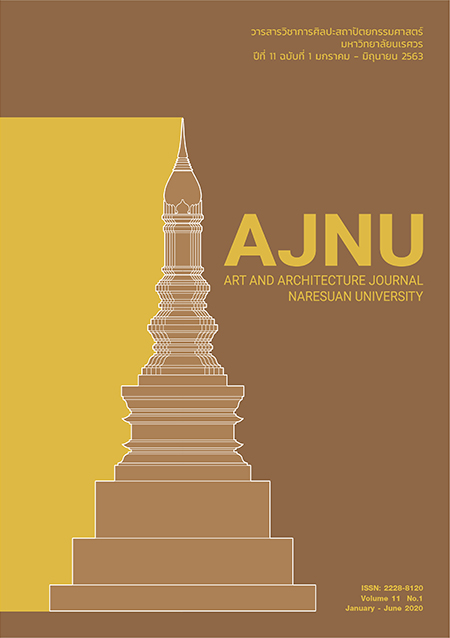Measurement for health and well-being for indoor lighting design
Main Article Content
Abstract
This paper is a research study of the criteria and indicators for qualitative measurement from WELL Building Standard, which is a health building assessment criteria and well-being for building occupants. The research study evaluates criterion of quality indoor lighting for health and well-being in comparison with the international standard green building assessment criteria such as BREEAM and LEED together with the Thai Green Building Assessment criteria (TREES). The results of comparison between WELL and the assessment criteria of other 3 green building standards found that when considering the weight of the points in the topics related to the health and well-being, all topics of WELL focus on occupants’ health issues. While 3 others green building criteria give priority to TREES, with the highest order, followed by BREEAM and LEED with 20%, 19%, 16% respectively. However, they were related to lighting only 7%, 6% and 8%. WELL has 16% of healthy lighting related topics, which is more than twice that of LEED, the highest lighting topic ranking first in all 3 criteria from the comparative study. In each of WELL’s health and well-being lighting topics, it is found that LEED is the most consistent in the details as high as 75%, while TREES is only 31% consistent. Results from the study also point out the lighting topics that can be considered as the main topic to be further developed for Thai green buildings standard, which conclude of 4 topics: Glare control, Electric light, Circadian light and visual balance. The additional alternatives of six sub-topics related to technical lighting design can also be considered in development. A set of data is developed in this research for use as a reference to the international criteria, which Will be an important guideline for considering and applying to define the norms and lead to the determination of lighting design criteria for health and well-being of Thailand
Article Details
References
Amundadottir, M. L., Rockcastle, S., Khanie, M. S., & Andersen, M. (2017). A human-centric approach to assess daylight in buildings for non-visual health potential, visual interest and gaze behavior. Building and Environment, 113, 5-21. doi:10.1016/j.buildenv.2016.09.033
Berson, D. M. (2003). Strange vision: ganglion cells as circadian photoreceptors. Trends in Neurosciences, 26(6), 314-320. doi:https://doi.org/10.1016/S0166-2236(03)00130-9
Bommel, W. v., & Beld, G. J. v. d. (2004). Lighting for work: A review of visual and biological effects (Vol. 36).
BREEAM. (2016). Technical Manual SD233 2.0. BREEAM International New Construction 2016, (SD233). United Kingdom.
Cajochen, C., L.Chellappa, S., & Schmidt, C. (2014). Circadian and Light Effects on Human Sleepiness–Alertness. 9-22. doi:10.1007/978-88-470-5388-5_2
Czeisler, C. A., Allan, J. S., Strogatz, S. H., Ronda, J. M., R.Sanchez, Rios, C. D., . . . Kronauer, R. E. (1986). Bright light resets the human circadian pacemaker independent of the timing of the sleep-wake cycle. Science, 233(4764), 667-671.
I.Friedman, D., & Dye, T. D. V. (2009). Migraine and the Environment. Headache: The Journal of Head and Face Pain, 49(6), 941-952. doi:10.1111/j.1526-4610.2009.01443.x
J.Aschoff. (1967). Human circadian rhythms in activity, body temperature and other functions. Life Sci Space Res, 5, 159-173.
L., E., & P., T. (2002). A Literature Review of the Effects of Natural Light on Building Occupants. National Technical Information Service U.S. Department of Commerce: National Renewable Energy Laboratory.
LeGates, T. A., Fernandez, D. C., & Hattar, S. (2014). Light as a central modulator of circadian rhythms, sleep and affect. Nature reviews. Neuroscience, 15(7), 443-454. doi:10.1038/nrn3743
LLC, D. L. (2014). WELL Building Standard. Delos Living LLC.
Marketingoops (Producer). (2018, 31 July ). Knowing LEED and WELL V.2, the concept of building standards for the world ... This era must have. Retrieved from https://www.marketingoops.com/news/brand-move/the-parq-leed-well/
PostToday. (2018, July, 11). RISC in collaboration with International WELL Building Institute (IWBI) pushes the building concept for good health in Thailand., online. Post today. Retrieved from https://www.posttoday.com/pr/563899
TGBI. (2017). TREES – NC Version 1.1. Thai’s Rating of Energy and Environmental Sustainability for New Construction and Major Renovation.
USGBC. (2018). LEED v.4 BD-C. Building design and construction.
WGBC. What is green building. Retrieved from https://www.worldgbc.org/
WHO. (2016). Preventing disease through healthy environments: a global assessment of the burden of disease from environmental risks.
จีรภา.รักแก้ว. (2018, June, 21). Mega Trend in Green Building changed the world. Green network, 86, 22-23.


